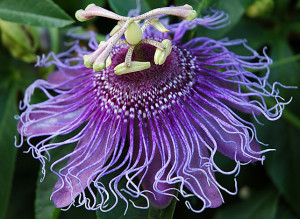Passiflora spp., more often known as the Passionflower Vine, is known for its stunning and unique flowers. You can find this semi-evergreen perennial vine from zones 6-11,  and it should be planted in full sun. Tendrils allow this vine to climb, and once established, the Passionflower Vine may be difficult to eradicate as it is known to be a rampant grower. You can expect this plant to reach anywhere from 15′ to 20′ in a single season depending on the variety you have selected and your location.
and it should be planted in full sun. Tendrils allow this vine to climb, and once established, the Passionflower Vine may be difficult to eradicate as it is known to be a rampant grower. You can expect this plant to reach anywhere from 15′ to 20′ in a single season depending on the variety you have selected and your location.
Varities
Passiflora incarnata is tolerant of drought, heat, and wet soils. This variety is native to the Southeastern USA from zones 7-10 with purple-blue to pink-lavender flowers or combinations of pink, purple, and white.
Passiflora coccinea is tolerant of drought, heat, and wet soils. This variety is not cold hardy and should be planted in sub-tropical regions from zones 9b-11. This variety has scarlet flowers and is much less vigorous than Passiflora incarnata.
Passiflora caerulea flowers with blue, white, and pink all found in the same flower, but it is less stunning than Passiflora incarnata and Passiflora coccinea. This variety is hardy from zones 8-11 and can withstand the cold temperatures of zone 7 (but will die back to the roots). The Gulf Fritillary Moth feeds on this plant in Central and East Texas.
Passiflora lutea flowers very small 3/4” yellow-green with purple-black fruit that cannot be eaten. This variety is the most cold hardy from zones 6-9 and is native from the Southeastern USA to Pennsylvania.
Passiflora vitifolia flowers a deeper red than Passiflora coccinea with grape vine-like leaves. This variety is hardy from zones 9b-11 and is known to be evergreen within the subtropical regions.
The Passionflower in Christianity
“The unusual shape of the flowers has led to the plant being associated in Christian symbolism with the passion of Jesus; the three stigmas representing the three nails used to nail Jesus to the cross, the ovary and its stalk represent the chalice of the Last Supper, the five anthers represent the five wounds, the corona represents the crown of thorns, the ten ‘petals’ (actually five petals and five sepals) the apostles (save Judas the traitor and Peter the denyer); the old leaves also represent the hands of those who persecuted Him, the young leaves are the point of the lance used to stab Him, and the tendrils the whips of those who beat Him.” (quoted from http://elimurray.hubpages.com/hub/The-Passion-Flower-in-Christianity)